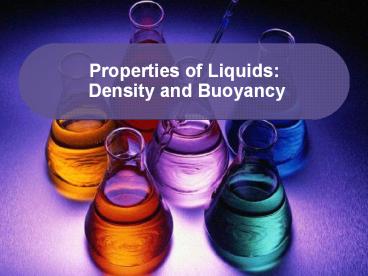Properties of Liquids: Density and Buoyancy - PowerPoint PPT Presentation
Title:
Properties of Liquids: Density and Buoyancy
Description:
Properties of Liquids: Density and Buoyancy Definitions Density: The mass per unit volume of a material. Buoyancy: The ability of a fluid to exert an upward force on ... – PowerPoint PPT presentation
Number of Views:278
Avg rating:3.0/5.0
Title: Properties of Liquids: Density and Buoyancy
1
Properties of Liquids Density and Buoyancy
2
Definitions
- Density
- The mass per unit volume of a material.
Buoyancy The ability of a fluid to exert an
upward force on a floating object.
3
Density
Densities of Common Materials
- The symbol for density is usually D and has units
of g/cm3. - Density is a physical property of a material.
- Often, a materials density is used to identify
it.
Water 1.00 g/cm3
Aluminum 2.7 g/cm3
Steel 7.9 g/cm3
Gasoline .70 g/cm3
Mercury 13.6 g/cm3
Air .0013 g/cm3
4
Density
m
- Solids, liquids, gases, and other phases of
matter all have densities. - Solids are most dense, liquids next dense, and
gases least dense - MOST of the time, density is inversely related to
temperature.
D
V
Which weighs more, A pound of feathers or a
pound of lead? Which is more dense?
5
Calculating Densities
Mass of the Sun 2 x 1030 kg
Volume of the Sun 1.4 x 1027 m3
Average Density of the Sun 1.4 g/cm3
6
Calculating Densities
Mass of the Earth 6 x 1024 kg
Volume of the Earth 1.1 x 1021 m3
Average Density of Earth 5.5 g/cm3
Does it make sense that the Earth is more dense
than the Sun?
7
A Density Problem
Does this help?
Metal Density g/cm3
Aluminum 2.70
Gold 19.30
Copper 8.63
Steel 7.87
Silver 10.40
Chromium 7.10
Lead 11.30
- You found this ring on the track at your school.
You wondered what it was made of. - You calculated its density to be approximately
7.9 g/cm3. - What is it made of?
8
Forces
- Newtons Laws
- 1.) The law of inertia An object in motion stay
in motion until it is acted upon. Or, an object
at rest stays at rest until acted upon. - 2.) F ma
- 3.) When two bodies interact by a force, the
force on the first body is equal in magnitude and
opposite in direction to the force on the second
body.
9
Archimedes Principle
- The buoyant force
- exerted on an object
- submersed in a fluid is
- equal to the weight of
- the fluid displaced.
10
But what does that mean?!?
- Fb DVg
- Fb Buoyant force
- V Volume of fluid displaced
- D Density of fluid
- g Acceleration due to gravity
11
Why does it float?
- For an object to float
- Wobject Fbuoyant
12
Buoyancy Calculations
- The polar bear on ice
- A 500 kg polar bear sees a slab of ice floating
by and tries to hop on. The ice has a volume of 4
m3 and a density of .92 g/cm3. Seawater has a
density of 1.035 g/cm3. Does the polar bear float
away happily?
Not this time! Fb 4140 N lt Wbear 4900N
13
Activity
- You will determine the density of a liquid and
use that density to identify the liquid. - Good luck!
14
Questions?































